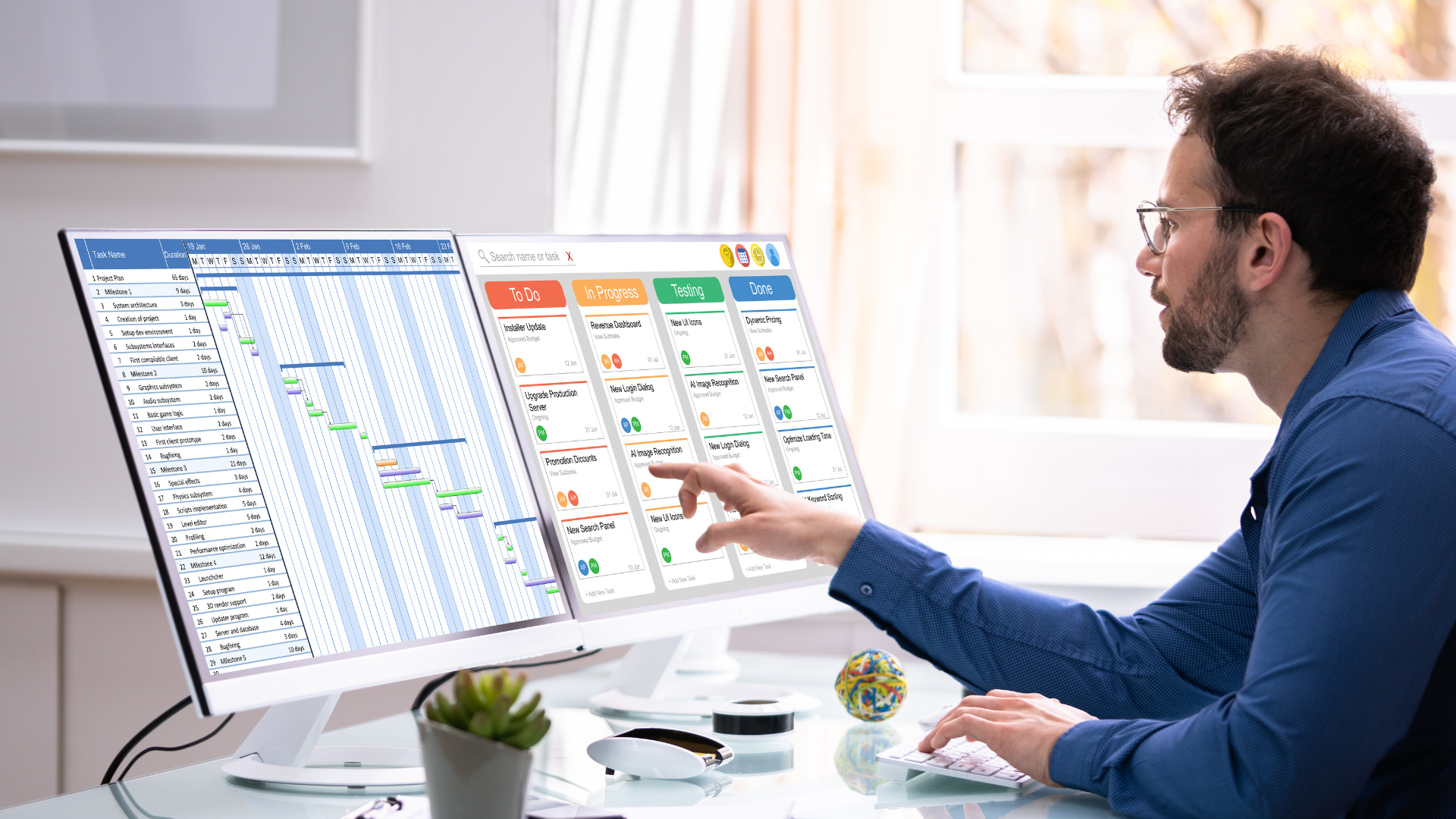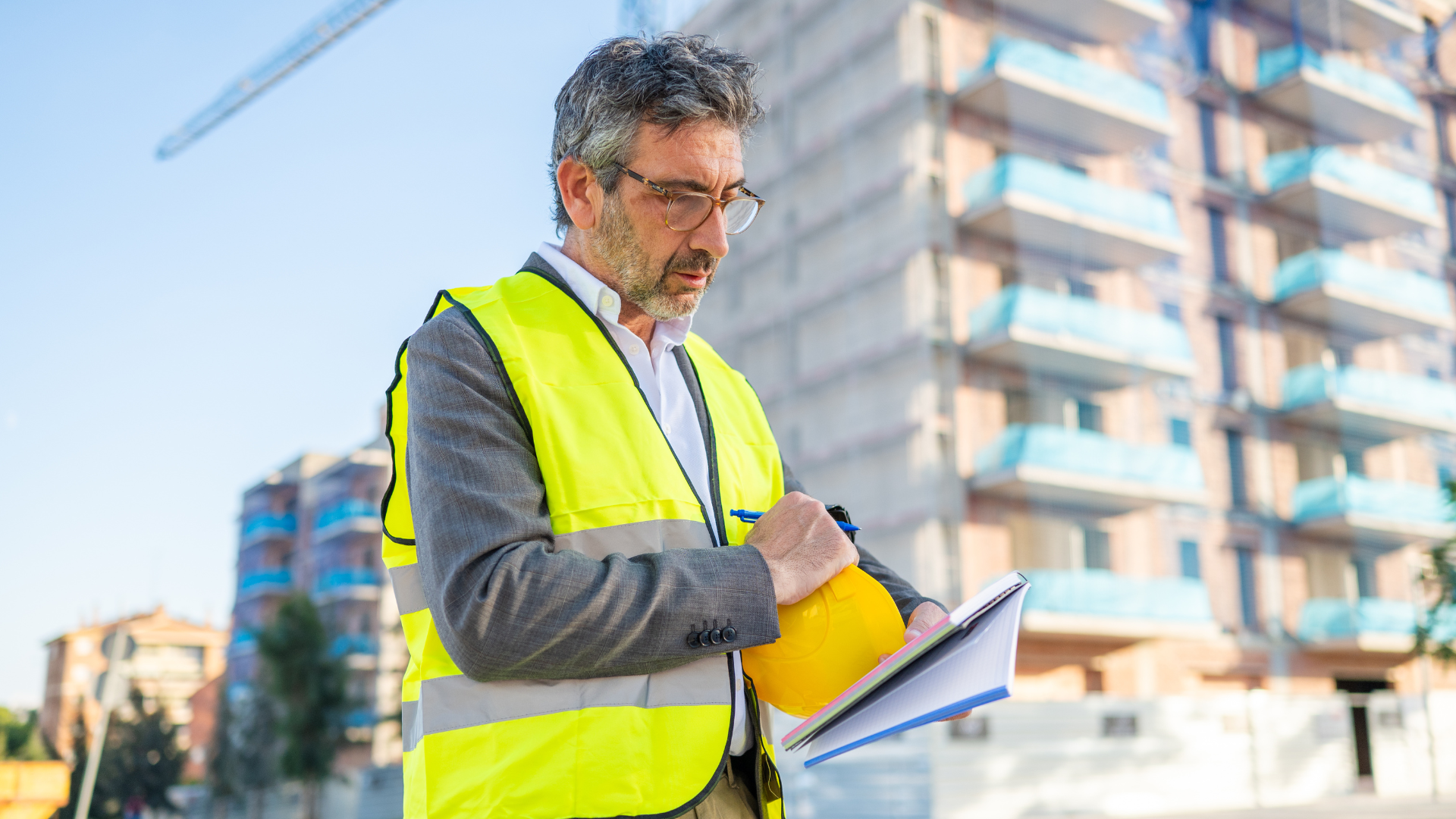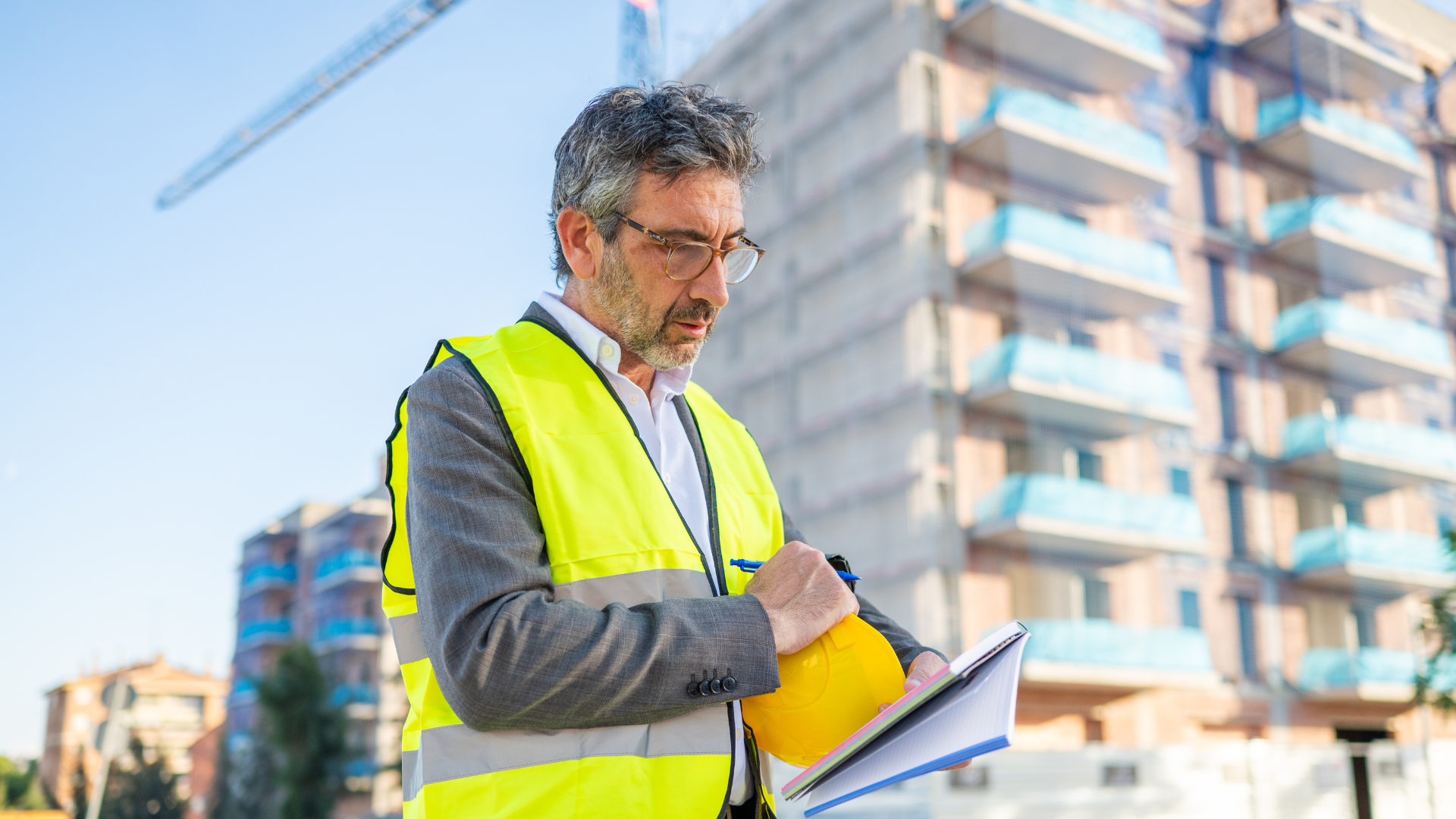The construction industry is growing rapidly, and AI is leading the way. From planning to scheduling to spotting risks before they happen, AI is helping project managers work smarter, not harder.
It cuts down delays, saves money, and keeps jobs on track. For roofing businesses, that means less stress and more profit. At ConstructionBase, we’re making AI tools practical and straightforward so you can stay ahead without needing to be a tech expert.
Moreover, with features like automated scheduling, intelligent material forecasting, and real-time updates, ConstructionBase puts the power of AI in your hands. It's built to help teams stay organized, efficient, and competitive.
How AI Is Changing Construction Project Management In 2025
If you've been anywhere near a construction site or a project meeting lately, you've probably heard this: AI in construction is no longer a futuristic concept. It's here, and it's changing the game.
From predictive scheduling to smarter budgeting and automation, artificial intelligence is quietly transforming the way construction companies plan, execute, and deliver projects.
And 2025 is shaping up to be a turning point. Why? Because we're finally seeing real results. Not just pilot construction projects or hype-filled headlines, but actual, on-the-ground improvements in project delivery that make daily work faster, safer, and more efficient.
So if you're a project manager, site supervisor, or construction business owner, it's time to tune in. Let’s walk through how AI is reshaping the construction industry in real time.
Key Takeaways
- Smart scheduling with AI helps reduce delays and downtime on job sites
- Predictive analytics help identify budget overruns and resource shortages before they happen
- Automation tools take over repetitive tasks so your team can focus on meaningful work
- AI-powered insights lead to better safety, higher quality, and faster execution on construction projects
The Construction Landscape In 2025
Let’s start with where things stand today. The construction sector is dealing with some serious challenges, such as:
- Skilled labor is harder to find than ever
- Projects are more complex, with tighter deadlines and stricter building codes
- Material costs are up, and so are client expectations
In short, traditional methods aren’t cutting it anymore, and that’s where AI tools come in.
Moreover, construction firms, especially medium and large ones, are turning to smart software to bridge the gap between outdated workflows and modern demands. Whether it’s using AI to monitor construction sites or leveraging historical project data, the shift is about working smarter, not just harder.
Why AI Adoption in Construction Is Accelerating in 2025
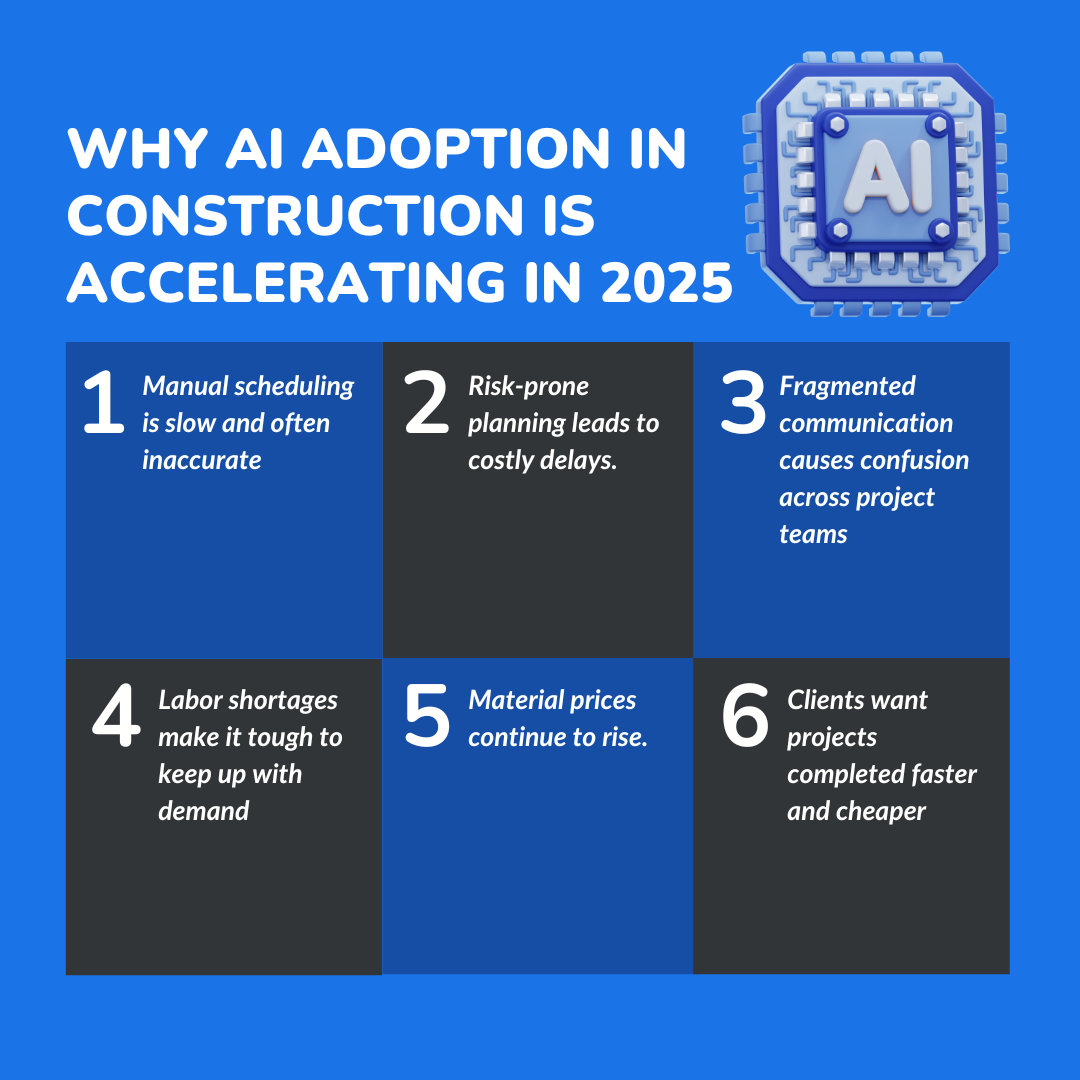
The adoption of AI technologies isn’t just a trend; it’s a response to real pain points in worker safety during the construction process:
- Manual scheduling is slow and often inaccurate
Project timelines constantly shift when schedules rely on spreadsheets and instincts, leading to inefficiencies and frustration on-site. - Risk-prone planning leads to costly delays
Without real-time data or predictive modeling, it’s nearly impossible to catch issues before they snowball into expensive rework. - Fragmented communication causes confusion across project teams
When everyone’s working off different documents or outdated plans, collaboration breaks down and mistakes multiply fast.
Meanwhile, outside pressures are mounting:
- Labor shortages make it tough to keep up with demand
With fewer skilled workers available, crews are stretched thin, forcing companies to do more with less, often at the cost of quality. - Material prices continue to rise
Fluctuating costs and unpredictable supply chains are wreaking havoc on budgets, pushing project margins tighter than ever. - Clients want projects completed faster and cheaper
Expectations have changed; stakeholders now demand on-time, on-budget delivery without sacrificing safety or performance.
In addition to that the growing investment in construction technology from both governments and private firms clears it: AI is not just helpful. It’s necessary.
AI isn’t a luxury anymore; it’s the backbone of modern construction.
What’s Driving Change?
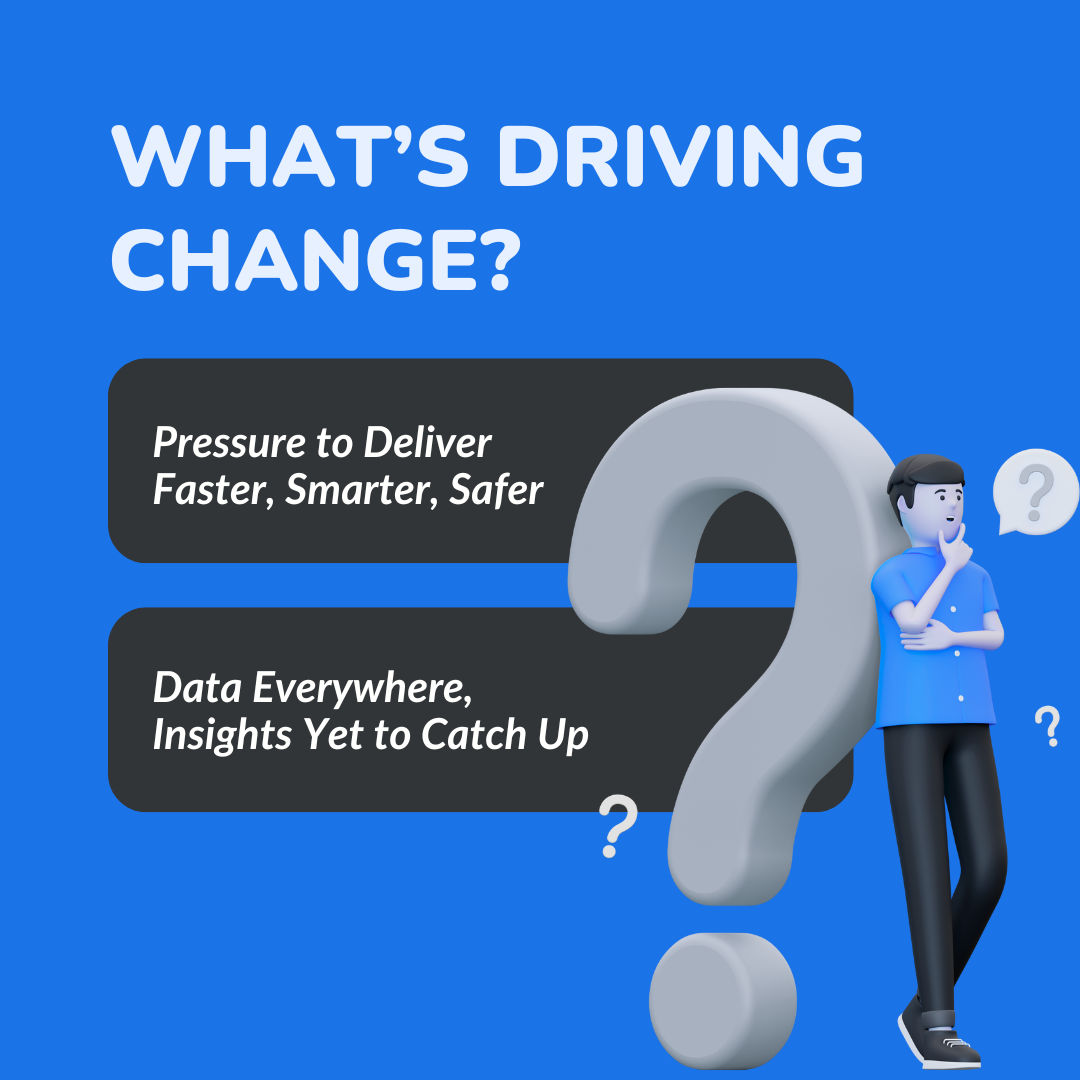
What’s really pushing the construction industry to embrace AI in 2025? It’s not just tech hype, it’s pressure. Projects are getting faster, bigger, and more complex.
At the same time, there’s more data than ever. Therefore, to stay ahead, construction companies need smarter systems powered by AI algorithms that can keep up and predict maintenance to deliver results.
1. Pressure to Deliver Faster, Smarter, & Safer
Gone are the days when "good enough" would fly. Clients now expect:
- Faster turnaround times
Deadlines are tighter than ever, and any delay, whether it’s materials or manpower, can cost thousands and damage reputation. - Better coordination across subcontractors
With multiple trades on-site at once, seamless communication is critical to avoid missteps and keep the build on track. - Fewer mistakes, especially in structural elements
There’s no room for error when it comes to load-bearing components or system installs; every mistake can mean major rework or safety issues.
On top of that, stricter safety standards mean construction companies must pay close attention to potential safety hazards and ensure workers are wearing protective gear. AI enhances safety monitoring and quality control by flagging risks early and automating incident reporting.
2. Data Everywhere, Insights Yet to Catch Up
Construction sites generate tons of data, from equipment usage to weather delays to inspection results. The problem? Much of it lives in silos, making real-time decision-making tough.
That’s changing with AI-powered systems that:
- Aggregate real-time data across teams
AI-powered tools pull data from field crews, office teams, equipment, and even drones into one centralized view so no one’s flying blind. - Use machine learning algorithms to identify patterns
These systems analyze past projects, current progress, and live conditions to spot trends like which delays are recurring or which crews outperform others. - Turn scattered information into actionable insights
Instead of digging through reports, project managers get real-time recommendations on what to fix, where to pivot, and how to avoid risk.
AI construction software promotes project collaboration and is finally bridging the gap between raw data and smart decisions.
AI-powered scheduling tools have helped reduce project delays by up to 20%, bringing more projects in on time and minimizing costly overruns for construction firms.
AI Applications Transforming Project Management
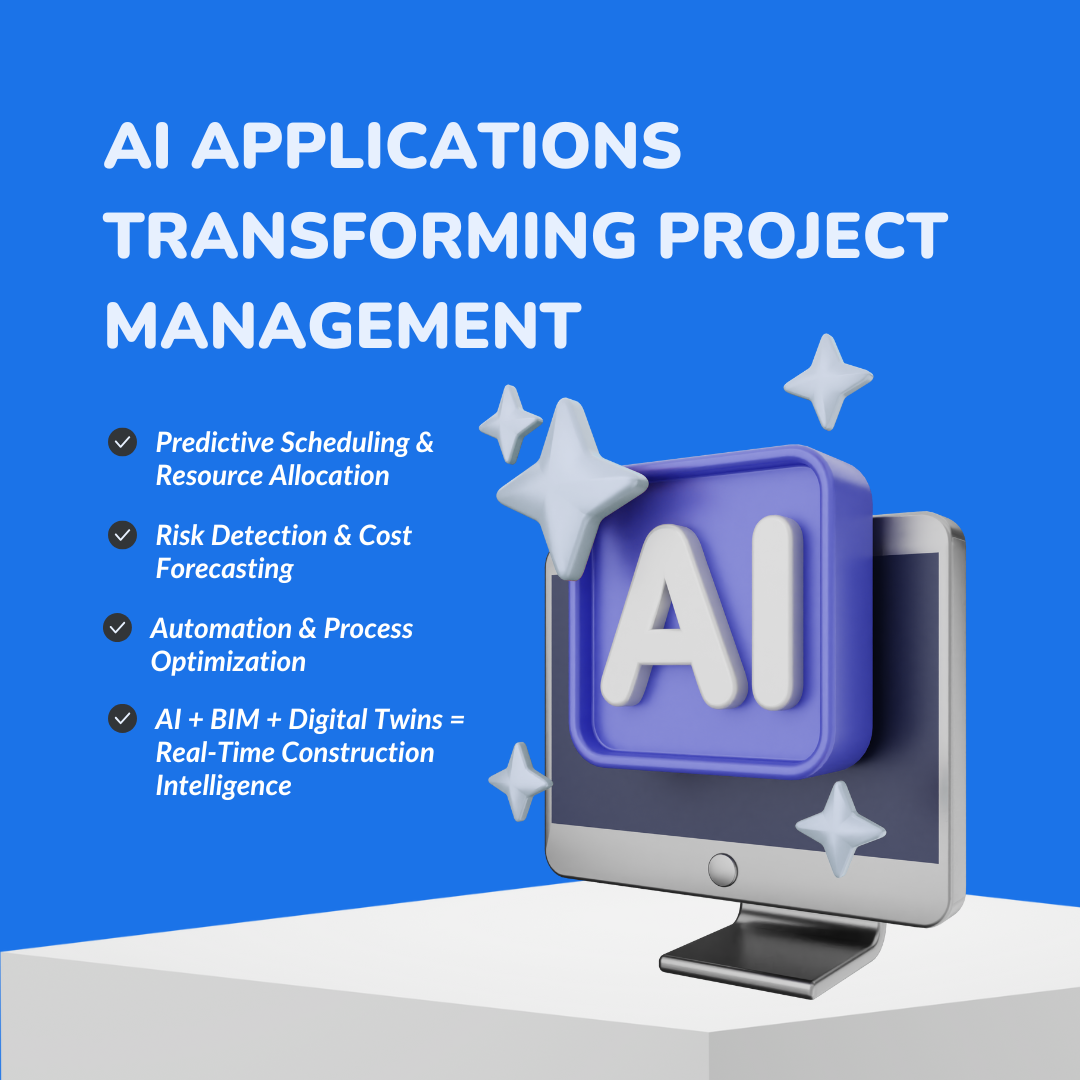
AI is changing how construction teams manage projects to improve efficiency, making them faster, safer, and easier to run. From intelligent scheduling to real-time risk alerts and automated reports, AI takes the guesswork out of the job.
Here’s how it’s transforming project management behind the scenes and saving time while doing it:
1. Predictive Scheduling & Resource Allocation
Imagine knowing a week in advance that your HVAC and electrical systems are going to experience a delay. Well, AI tools can make that a reality by analyzing past projects, real-time inputs, and weather patterns to:
- Predict project delays before they happen
AI software looks at your project’s history, supplier data, and even the weather forecast to spot potential slowdowns before they hit your schedule. - Optimize resource allocation for labor, equipment, and materials
By analyzing trends and current workloads, AI helps you deploy the right people and tools exactly where and when they’re needed most. - Minimize downtime with better staging plans
Smart scheduling tools create smoother handoffs between trades, reducing idle time and keeping your construction tasks moving without costly gaps.
The result? Smoother execution and happier clients.
2. Risk Detection & Cost Forecasting
Risk management is no longer guesswork. With AI:
- Budget overruns can be flagged weeks ahead
AI tools monitor spending in real time and compare it with historical data and benchmarks to spot when costs are drifting off course before it’s too late. - Cost estimates are automatically adjusted based on market trends
By tracking shifts in material prices and labor rates, AI systems keep your estimates current, helping you avoid surprises and protect your margins. - Scope creep can be identified early using project specifications
When work starts drifting beyond the original plan, AI flags inconsistencies in the project lifecycle so teams can take corrective action before things spiral. These capabilities are beneficial for large-scale projects where even minor issues can lead to massive costs.
3. Automation & Process Optimization
We all know how much time is wasted on repetitive tasks: paperwork, reporting, material orders, and compliance checks. AI systems handle these, so your project managers can focus on high-value decisions.
- AI software automatically generates daily progress reports
Instead of chasing updates from every corner of the site, AI compiles input from workers, sensors, and equipment to deliver ready-to-go reports each day. - Automated ordering of materials when inventory is low
When stock runs low, AI triggers purchase orders based on real-time usage and delivery lead times, eliminating the need for last-minute supply runs. - Compliance checks are done in real time through AI-powered tools
From safety protocols to local building codes, AI systems scan checklists and documentation continuously to ensure you're always audit-ready and up to code.
If you are juggling with labour shortage, have a look at this: How to Overcome Labor Shortages in Construction.
4. AI + BIM + Digital Twins = Real-Time Construction Intelligence
Building Information Modeling (BIM) was already a leap forward. Now add advanced natural language processing to AI, and you get digital twins: living, breathing models of construction projects that update in real time.
By syncing BIM with IoT sensors on site, AI helps:
- Track progress against project timelines
AI taps into real-time data from IoT sensors to monitor what’s happening on-site, flagging when tasks fall behind or get ahead of schedule. - Simulate future issues before they happen.
Digital twins enable teams to model "what-if" scenarios, allowing you to identify design clashes, weather delays, or material shortages before they impact your project. - Enable remote collaboration and virtual walkthroughs.
With AI-enhanced BIM, stakeholders can log in from anywhere, explore 3D site models, and make decisions without setting foot on-site.
It’s not just project planning anymore. It’s real-time project control.
AI adoption in construction is accelerating worldwide, with the market projected to reach $4.86 billion in 2025 and $22.68 billion by 2032, growing at a CAGR of 24.6%
Real-World Impact: Metrics That Matter
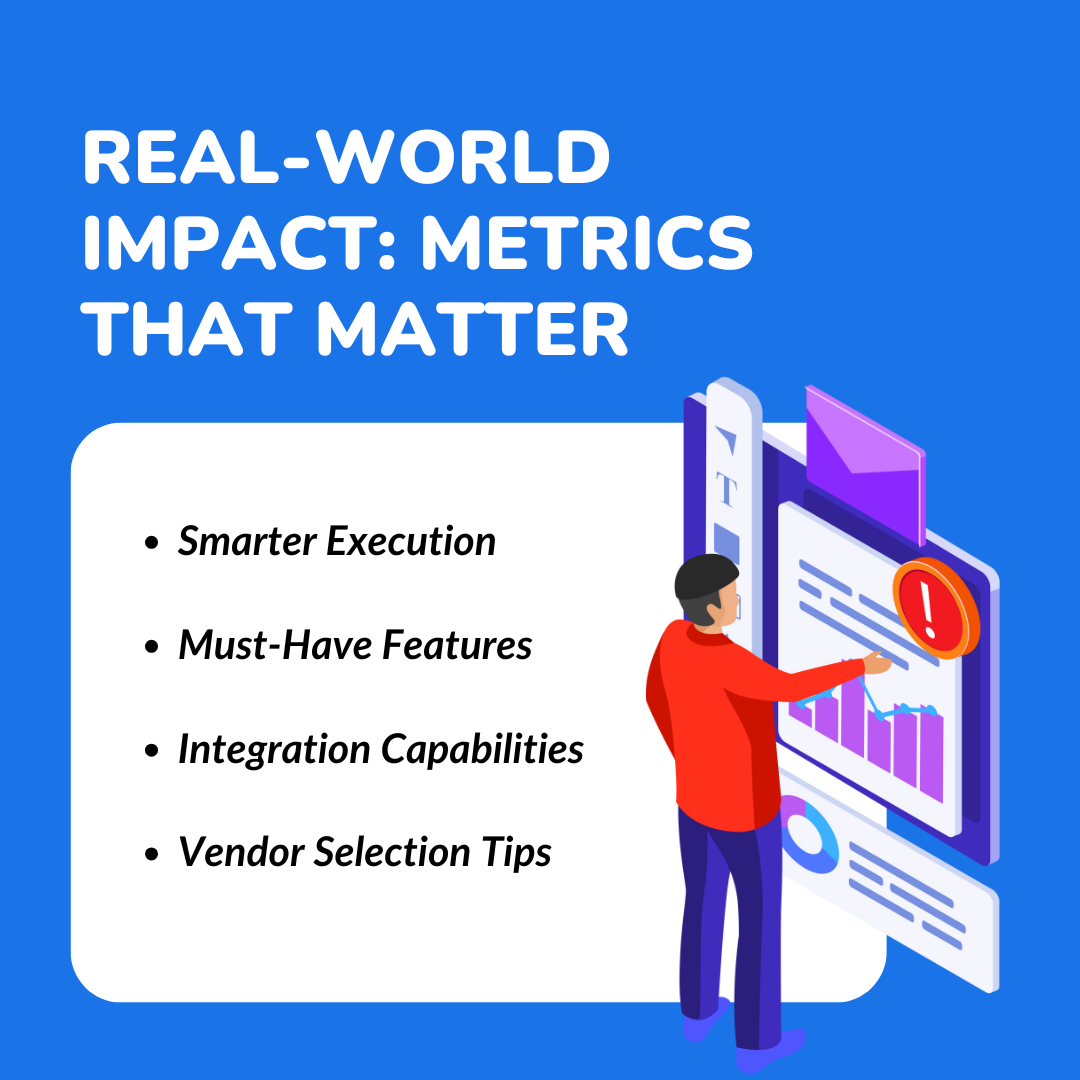
Still wondering if all this is just hype? Here are some real numbers from construction professionals using AI:
Smarter Execution:
- Less time spent on admin
Project managers and teams are spending fewer hours on reports, checklists, and scheduling, freeing them up to focus on the build itself. - More efficient use of resources
AI helps prevent waste by optimizing how labor, materials, and equipment are planned and used throughout the project lifecycle. - Faster project timelines
With delays predicted before they happen and schedules adjusted in real time, teams are staying on track and even finishing early. - Stronger quality control
AI-driven inspections and real-time validation catch issues as they arise, which means fewer mistakes and better craftsmanship overall. - Improved job site safety
Predictive maintenance and intelligent monitoring tools reduce equipment failures and flag risks, helping to keep everyone safer on-site.
Not all AI construction software is created equal. Here’s what to look for:
Must-Have Features:
- Predictive scheduling tools
These help you spot delays before they happen so you can adjust plans in advance. - Budgeting dashboards
Give your team a clear view of project costs, spending trends, and financial risks in one place. - Risk assessment and alerts
Instantly flag issues like scope creep or safety concerns so nothing slips through the cracks. - Mobile-friendly collaboration features
Let teams update progress, share files, and communicate directly from the field without needing a laptop. - Integration with BIM and other construction technologies
Keep all your tools connected so project data flows smoothly across platforms and teams.
Integration Capabilities:
- Analytics platforms for better forecasting
Connect with data tools to predict delays, cost overruns, and performance issues before they happen. - Safety systems for monitoring construction sites
Sync with safety tech to track hazards, equipment usage, and compliance in real time. - Procurement platforms for smarter purchasing
Integrate with procurement tools to automate orders and make informed buying decisions based on project needs.
Vendor Selection Tips:
- Look for domain-specific tools built for the construction industry
Choose software that’s designed specifically for construction workflows so it fits your day-to-day operations. - Prioritize companies with strong onboarding for non-tech users
Choose vendors that provide easy training and support, helping your team adopt the software without frustration.
ConstructionBase: A Blueprint of AI-Powered Project Management
If you’re serious about upgrading your project management, ConstructionBase is worth a look. Built specifically for the construction sector, it delivers on what matters most:
Core Features:
- AI‑powered job scheduling that learns from past projects
Learns from previous timelines and delays to help you auto‑optimize schedules and keep crews on track. - Smart alerts for resource shortages and timeline shifts
Sends real‑time warnings if labor, equipment, or materials are running low or deadlines are slipping. - Budget forecasting and cost control
Tracks expenses live, compares them to estimates, and flags financial risks before they escalate. - Risk analysis with built‑in triggers
Scans your project’s progress and specifications to highlight issues early, before they impact execution. - A central hub for collaboration between project teams
Bring scheduling, documents, reports, and communication into one platform so everyone stays aligned.
Why It Works:
- Designed with contractors in mind, not just tech pros
ConstructionBase prioritizes ease of use for field teams, so even non-technical users can adopt it quickly with minimal training. - Fast setup and intuitive workflows
From onboarding to daily tasks, users report getting up and running in just a few days thanks to straightforward navigation and hands-on support. - Connects analytics to real-world actions
Live data on budgets, progress, and resource use is instantly tied back to scheduling decisions so that teams can act immediately. - Helps project managers monitor construction sites with ease
Real-time site visibility from crew deployment to safety compliance is built into dashboards so oversight becomes proactive, not reactive.
ConstructionBase isn’t just another tool. It’s a project partner.
How to Overcome Adoption Barriers
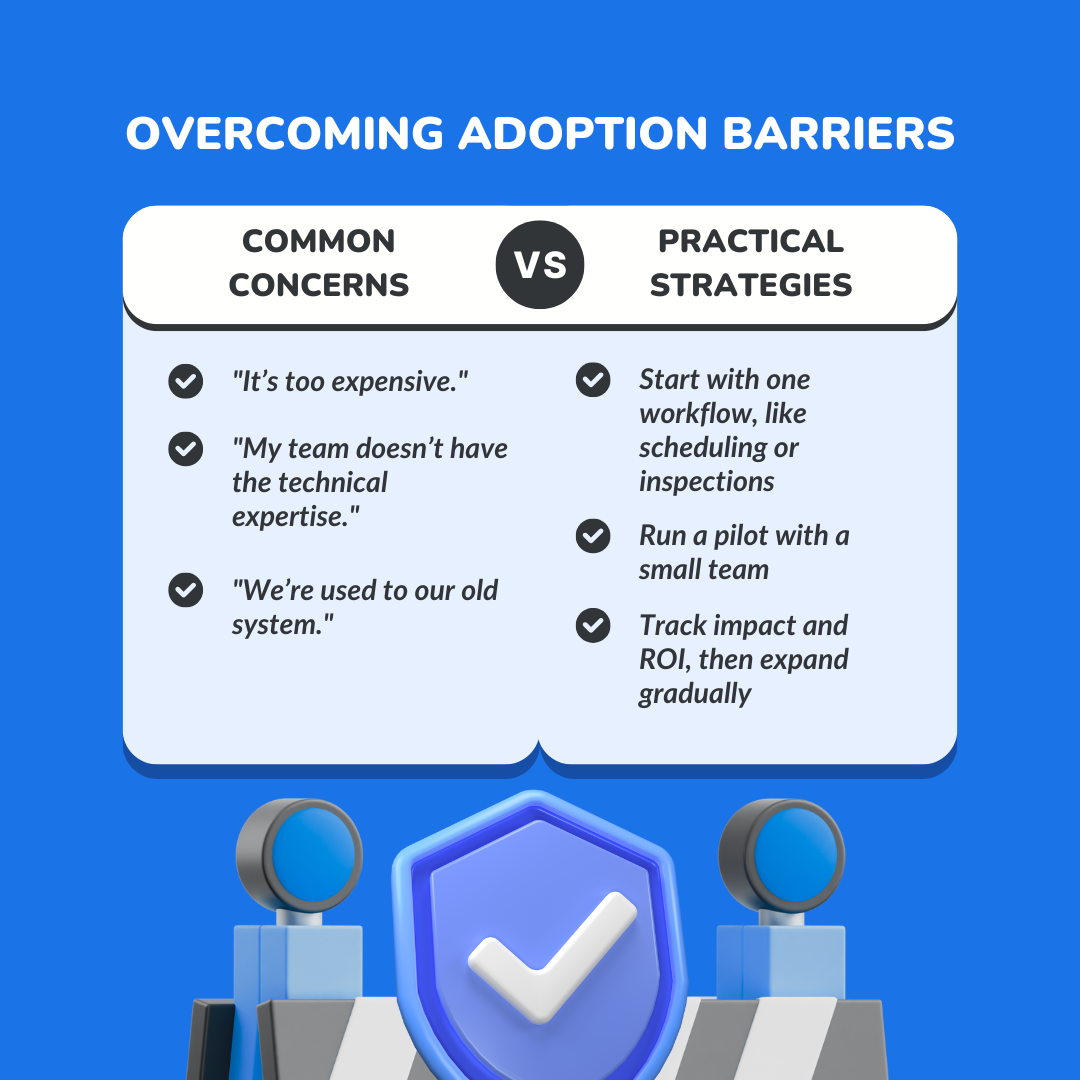
Adopting new tech is never easy. But here’s how to make it work:
Common Concerns:
- "It’s too expensive."
Many worry about upfront costs, but modern AI tools often offer scalable pricing and deliver long-term savings. - "My team doesn’t have the technical expertise."
Most AI platforms today are built for ease of use, with simple interfaces and dedicated onboarding support. - "We’re used to our old system."
It’s hard to break habits, but even minor improvements in speed or accuracy can quickly outweigh the comfort of outdated tools.
Practical Strategies:
- Start with one workflow, like scheduling or inspections
Focusing on one area helps teams learn the system without getting overwhelmed. - Run a pilot with a small team
Testing new software in a low-stakes environment helps surface feedback and build early buy-in. - Track impact and ROI, then expand gradually
Once you see precise results like time saved or fewer delays, it becomes easier to justify broader adoption. AI adoption doesn’t have to be all or nothing. Small wins build momentum.
The Road Ahead: What’s Next?
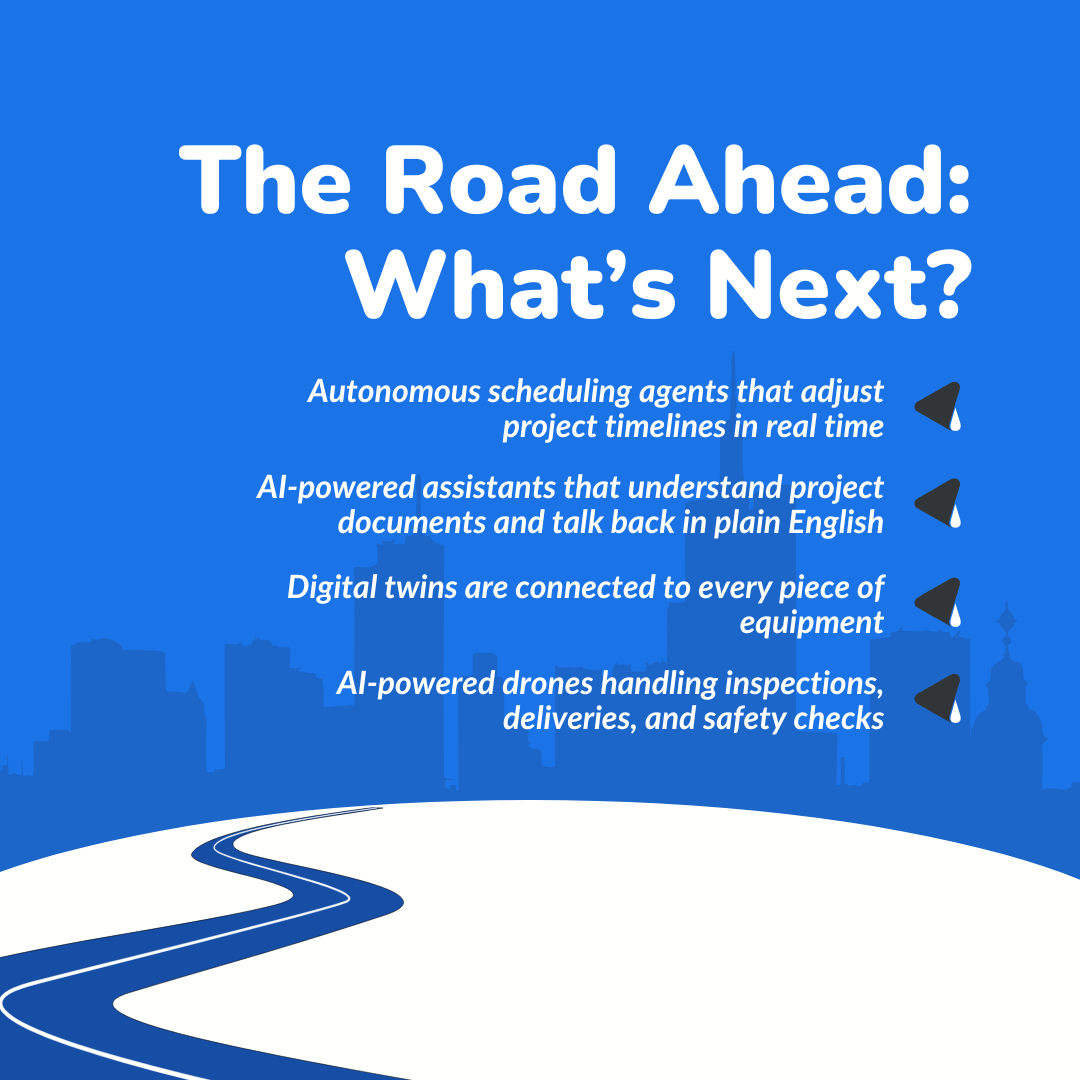
We’re just at the beginning of what AI can unlock in construction. As the tech matures, the possibilities ahead are pretty exciting, and they’re not as far off as you might think.
- Autonomous scheduling agents that adjust project timelines in real time
Imagine an intelligent assistant that not only reminds you of deadlines but also shifts the entire schedule when a delay hits, re-routing crews, rescheduling deliveries, and updating timelines automatically. No more scrambling to fix conflicts at the last minute. - AI-powered assistants that understand project documents and talk back in simple language
Thanks to advances in natural language processing, future AI tools will be able to read your blueprints, permits, and contracts, then answer your questions like your teammate. Whether you’re on-site or in the office, you’ll be able to ask things like “Where’s the next inspection due?” or “Which subcontractor is behind?” and get clear, instant answers. - Digital twins are connected to every piece of equipment
Picture a fully digital replica of your job site that updates in real time, tracking everything from cranes to compressors. These smart twins will help you monitor wear-and-tear, detect performance drops, and ensure every asset is being used efficiently across the entire project lifecycle. - AI-powered drones handling inspections, deliveries, and safety checks
Drones are getting smarter, too. Soon, they won’t just take pictures from above; they’ll scan for structural issues, transport small materials between areas, and patrol for safety violations, all guided by AI.
It’s not about replacing people. It’s about giving construction professionals the tools they need to thrive in a complex, fast-moving world.
Final Thought
AI in construction is no longer a future concept. It's the new reality. From predictive scheduling to risk management, from automation to real-time insights, AI-powered tools are giving construction firms the edge they need to succeed in 2025 and beyond.
Moreover, the construction industry has always been about building. Now it’s time to build smarter with innovative solutions.
Looking to future-proof your construction business?
It might be time to move beyond traditional project management methods and begin utilizing AI. Get started with ConstructionBase.
Let's build smarter together- Book your demo today!
FAQs
1. What is AI in construction?
AI in construction refers to using machine learning, automation, and predictive analytics to streamline construction tasks like scheduling, budgeting, inspections, and resource management.
2. Can AI help reduce project delays?
Yes. AI algorithms can predict delays and predictive maintenance based on past data, weather, and site conditions, allowing teams to plan ahead and stay on schedule.
3. Is AI suitable for small construction companies?
Absolutely. Tools like ConstructionBase are designed to be user-friendly and scalable, making them ideal even for teams without deep technical expertise.
4. How does AI enhance safety on job sites?
AI systems can monitor construction equipment, detect safety hazards, and ensure that workers are wearing protective gear, significantly improving site safety.
5. What does predictive maintenance mean in construction?
It means using AI to forecast when equipment or systems (like HVAC and electrical systems) are likely to fail, so maintenance can be done proactively instead of reactively.
Have questions or need personalized advice?
Talk to an Expert Today and let our construction specialists guide you to success.



